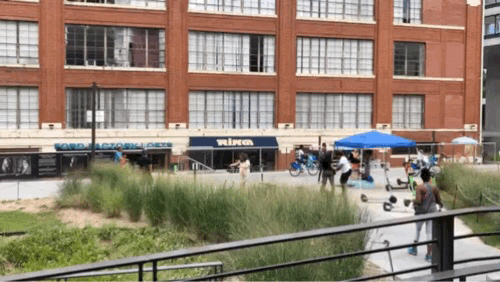On Supercharging the Streetlight
Over the past few months, I’ve thought about ways that cities could expand access to chargers across the country, but I was stuck. Whether it was installation barriers for MFD property owners, a peer-to-peer charging network, or relying on corporations like GM or public utilities to provide access, they all seemed to be limited by creeping land use and individual decision makers.
On Designing Livable Cities for All
Trees are still the most effective and affordable way to sequester carbon. On average, a single tree sequesters 50 lbs of carbon dioxide a year. Over the average 40-year lifespan of most urban trees, that’s roughly 1 ton of carbon dioxide per tree. With an estimated 5.5 billion trees in urban areas alone, you get 137.5 million tons of carbon sequestered from the atmosphere from urban forests every single year and 5.5 billion tons over 40 years — a small investment with a big ROI.
On Saving Money as a Climate Solution
Sense-induced energy reductions will vary from house-to-house and depend on a variety of factors, including energy provider (and their fuel mix), whether the home has solar and a battery, and how many appliances are gas-powered vs. electricity-powered.
On Building the Future
My goal with this newsletter is to learn in public about the ideas, concepts, and companies that give us hope for a future where our built environment makes us healthier, not sicker. I’ll explore the promises of climate impact, the science, how it impacts you, and how you might get involved.
Advocating for Small Urban Spaces and New Global Corporate Sustainability Standards
If your employers don't already have a sustainability program, urge them to create one. If you have a staff sustainability manager, encourage the use of a CMAP like Watershed to create public accountability and general sustainability transparency for your colleagues, your customers, and the general public.
In a World of Climate Solutions, Policy Needs a Boost
Technology is not holding us back. Policy is. From a physical science perspective, despite learning ground truth about the effects of climate extremes on individual regions, the reality is we're not learning new things about climate change. It's an exclusively political problem. The potential mechanisms to solve climate change exist, we just need to put them into place now.
Why I’m Buying Into The Great Teslafication
Because public policy attempts to move our cities forward collectively, it runs into problems with consensus, education, and inclusion. Where the reach of public policy influence ends, private industry takes over, creating commercial solutions that address the collective demands of private citizens through innovation and design. As a result, we’ve slowly added better, cheaper insulation to our homes during renovations, installed more efficient tankless water heaters when our old natural gas tanks fail, and even become fanatics of electric vehicles.
Sometimes, as is the case with consumer brands like Tesla, a fanatical following can push collective demand through vanity, envy, and prestige.
Testing Concepts on Reddit, Learn from Burns
It's easy to get lost in these trendy concepts that are intentionally designed to conjure an image. They quickly take me down a path of exploration where I might combine several shiny ideas to create my own little concept city. But just as easily as these ideas come, they can and should be challenged.
In Atlanta, the BeltLine Approaches Climate Change by Design
Not only does the BeltLine aim to revitalize unused and abandoned railways, but this rails-to-trails initiative is paving the way for a stronger relationship between people and their built and natural environments.
From Vision to Strategy: Why IKEA’s Urban Village Project is the Perfect Testbed for Urban Innovation
Earlier this year, I had the fortune of meeting the UVP lead at Space10 over Google Meet. We discussed the status of the project, potential timelines, and shifts in goals, guideposts, and realities. As with most projects in 2020, conceptual or not, the Covid-19 pandemic put a damper on productivity and feasibility, drawing many projects to a halt. Although I cannot speak for the Space10 or EFFEKT regarding the future of the project, it's something I continue to root for to see in our future.
How OKRs Enhance Planning for the Future of Cities
Restructuring cities to function as a tech product would help to realign the goals of the cities to match the users ("the citizens") with the features ("policies") that represent the population rather than the other way around.
In my opinion, the future of cities needs product managers. The goal of these public officials would be to understand the needs of the people and to define the goals and OKRs of their population — selecting programs and initiatives like features that accomplish those goals. In one sample case, the OKRs would optimize for several key values — improving equitability, improving access to resources, improving investment in innovation.
Oakland Slow Streets, A Call for More Data in Iterative Urban Planning
Although Oakland's approach to urban data is both underwhelming and ill-equipped, it presents an opportunity to drastically improve its approach from intercept surveys, OPD crash data, and maintenance interviews. Lightweight automated tracking and sensor-based solutions present an opportunity to collect de-personalized movement and count data that is far more accurate and functionally cheaper than people.
In Portland, 15-Minute Neighborhoods Focus on the People
Walkability may not be top of mind for the average Portland tourist like it is in New York City, but it's a clear benefit if you're staying on the Eastside of the river. Nearly every neighborhood on the Eastside of Portland features a wonderful new restaurant or neighborhood institution that anchors public thoroughfare — featuring a combination of lively walking culture with convenient corner markets and small local businesses cozily mixed in with commercial complexes, light industrial, and modern one-plus-five mid-rise apartments.
How Six Inches of Concrete Can Mean Life or Death
In 2019, 134 pedestrians were killed by drivers while walking in Los Angeles, a bustling city with a population of just under 4 million. By comparison, the Netherlands reported a total of 49 pedestrian road fatalities in 2019 in a population of more than 17 million. While any number of deaths is too much by any measure of success, it's safe to conclude that the Dutch are doing something far more effective than what's happening in one of the largest cities in the United States.
Why Carbon Accounting Falls Short and We Can Do
Despite growing pushback against carbon footprint calculators, I believe that the data behind our individual impact on the planet is valuable. Our personal emissions data does not absolve corporations from polluting but instead drives home a valuable message about the trifecta of reducing the cost of lifestyles, holding corporations accountable, and encouraging investment into environmentally friendly products.
What Can I Do On Earth Day?
Something happened over the last few years that changed my perspective on climate activism. I was never a conspiracist or non-believer in climate change, but just as bad, I was a passive global citizen and inactive participant in the fight to reduce carbon emissions.
Why a Three-Pronged Approach Will Create Resilient Cities
Cities are never finished. Like good tech products, they require regular maintenance, periodic refactoring, and new features to meet the needs of a growing population.
Anthropology and social science uncover the questions that we need to answer with technology. Technology enhances our understanding of human behaviors through quantifiable data. Data improves our ability to communicate effectively through words, laws, and policy. Policy and planning enhance the lives of people in our cities.
What Is A Soft City and Why Do We Need Them?
Soft may not be as sexy as Smart, but it emphasizes the small details in a city and its buildings that make our lives easier, more enjoyable, and more efficient by prioritizing the people that live in it.
Why Data Alone Won’t Save Cities
I subscribe to the notion that the design of our cities is the driving force behind our choices and behaviors. Although I’m still working on a thesis to summarize my views on cities and climate change, my general hypothesis is this:
If our behaviors control how humanity impacts climate change, then our cities are the first and last battleground for defeating the global climate crisis.
Why New Isn't Always Better for City Redevelopment
Not only did Lacaton & Vassal beautify the building with a shining new glass facade that created more living space for its residents, but the project was less expensive and more environmentally sustainable.
Reframing the scope in the PD phase from rebuilding to remodeling reduced the amount of demolition, new material, and labor effort. With a modular-design, each terrace was was built as a minimalist, portable, and stackable unit, which made cost-effective prefabricated construction a viable option.





















